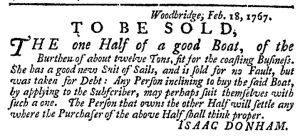GUEST CURATOR: Shannon Dewar
What was advertised in a colonial American newspaper 250 years ago today?

“TO BE SOLD, THE one Half of a good Boat.”
In many of the newspapers I looked through for this week, the sale of ships really struck me as a common trend, including this advertisement from Woodbridge, Connecticut. That town is located next to New Haven, which is located directly on the Long Island Sound. This made is a great location for coasting into New York and doing business there. This form of commerce was part of what historians call coastal trading. Rather than investing in transatlantic voyages between the colonies and England, many merchants focused on moving goods between the colonies, up and down the North American coast. In The Economy of Colonial America, Edward J. Perkins states, “[T]he real strength of the colonial economy was its prodigious agricultural production for local consumption and urban centers. The value of good and services for strictly internal consumption outweighed by far the volume of colonial exports.”[1]
Perkins states, “Colonial shipowners were also permitted to participate fully in the empire’s North Atlantic trade. Along with shipowners in the mother country’s they enjoy protection inside the empire from competition with the Dutch, French, Spanish and other outsiders.”[2] This allowed a growing coastal trade to develop. In addition, due to limited roadways and other means of transportation on the mainland, coastal trading provided an efficient alternative for colonists to move goods and earn money.
**********
ADDITIONAL COMMENTARY: Carl Robert Keyes
During the initial round of selecting advertisements to examine during her week as guest curator of the Adverts 250 Project, Shannon chose several that announced ships for sale. Among those, Isaac Donham’s notice was unique in that he sold only “one Half of a good Boat … fit for the coasting Business” rather than ownership of an entire vessel. Donham explained that the “Person that owns the other Half will settle any where the Purchaser of the above Half shall think proper.” For all intents and purposes, Donham was selling a stake in a partnership with another colonial merchant.
As Shannon explains, coastal trading offered opportunities for some colonists to acquire significant wealth, but that did not mean that anyone who dabbled in moving goods between the colonies was guaranteed financial success. Coastal traders needed to be savvy entrepreneurs – and a little bit of luck never hurt anyone pursuing business opportunities. Acquiring goods to import and export among colonies represented a significant investment itself. Many merchants paid to have their goods transported on vessels owned and operated by others who regularly advertised freight services in colonial newspapers. Some of the most affluent colonial merchants sought to reduce those expenses by investing in their own ships. For those who could not afford to do this on their own, forming a partnership with one or more other merchants became a viable alternative.
Whatever the circumstances, one of Donham’s associates found himself in over his head, unable to pay his bills. He promised that there was nothing wrong with the vessel itself (“sold for no Fault”); instead, it had been “taken for Debt.” Donham apparently did not wish to operate the vessel in partnership with the “Person that owns the other Half,” preferring to sell the stake he had acquired when seizing the ship and recoup the funds owed to him. Participating in commerce in the colonies presented many opportunities for economic advancement, but with those opportunities came risks and, sometimes, failures. The matter-of-fact language in today’s featured advertisement disguised a drama that unfolded around one unfortunate merchant, his family, and his associates.
**********
[1] Edward J. Perkins, The Economy of Colonial America, 2nd ed. (New York: Columbia University Press, 1988), 43.
[2] Perkins, Economy of Colonial America, 41.
